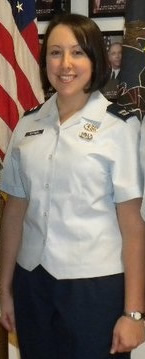
When choosing an online learning environment, what should you look for? What are your needs? Did you know that the delivery of online content to learners is most often done through a learning management system (or LMS)? Penn State World Campus currently uses the University Learning Management System, which is ANGEL 7.4.
Recently Kristin Bittner, Penn State World Campus instructional designer and an education officer for the Pennsylvania Air National Guard, contributed to an article titled “In the classroom – What to look for in an online course” by Jessica Lawson. The article was featured in Military Times EDGE, a publication dedicated to helping service members with strategies and tips relevant to both educational needs and professional careers.
According to Bittner, students should “choose a school based on quality, reputation, access, flexibility, delivery, and technical support, not on the brand of course management system.” They all have advantages and disadvantages, Bittner said: “None of them are perfect. Each LMS brings a different set of strengths and weaknesses.”
At Penn State World Campus Learning Design, “we redesign courses to be delivered online. We don’t just take a classroom course and put it online and expect it to work,” Bittner said. “Penn State faculty work with instructional design specialists and staff who help them make that transformation. Faculty are experts in their field — not experts on how to make something work in a learning management system.”
What will you find in a Penn State World Campus course?
“The syllabus, lesson content, links to reading materials, videos, discussion forums, activities, quizzes, and exams are all in one place,” Bittner said. “A student will also find video segments, simulations, and graphics in the courses in order to help visualize certain concepts,” she added. And some courses also use synchronous collaboration tools that allow student groups to meet to conduct course projects and allows faculty to provide tutoring sessions or short presentations.” Some examples of synchronous collaboration tools that Penn State World Campus uses are Elluminate Live!, Google Docs, Skype, and ANGEL chat.
Flexibility/Accessibility also is key.
“There are some synchronous aspects of some of our courses,” Bittner said. “If an online course invites a guest speaker to speak live online with the class, we record the session so students can watch it later if they cannot attend in real-time. The courses I support tend to make these opportunities optional so students’ grades won’t suffer if they can’t attend. We design with all sorts of limitations in mind.”
Have questions or need technical support?
“Adult learners want their questions answered right away,” Bittner said. “At Penn State World Campus, you can call, e-mail, or chat with tech support online. We also have an online knowledge base. There is a place to find an answer no matter what time it is.”
About Kristin: Prior to joining Penn State as an instructional Designer with the online criminal justice and homeland security programs, Kristin was an instructional designer for Lockheed Martin and designed aircrew training for the U.S. Air Force. She has 10 years of military service.
Kristin is currently working on developing a Faculty Development course to help faculty understand how to better serve the military student. Are you serving in the military or do you come from a military background? Do you have a student experience you would like to pass along? We would love to hear from World Campus students on how we can help you!
All quoted material in this blog post was originally published in Jessica Lawton’s article “In the classroom: What to look for in an online course” in Military Times Edge.


